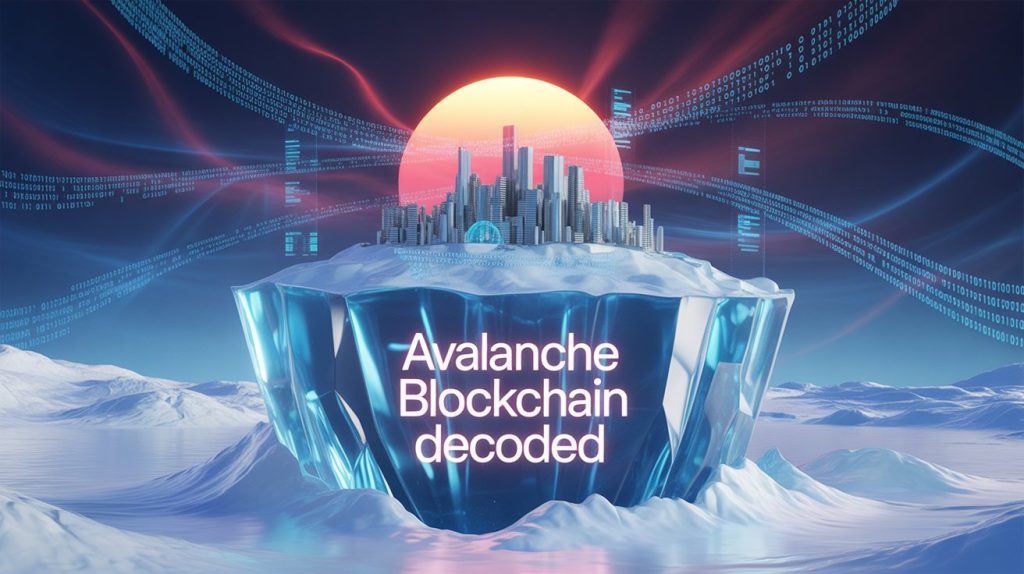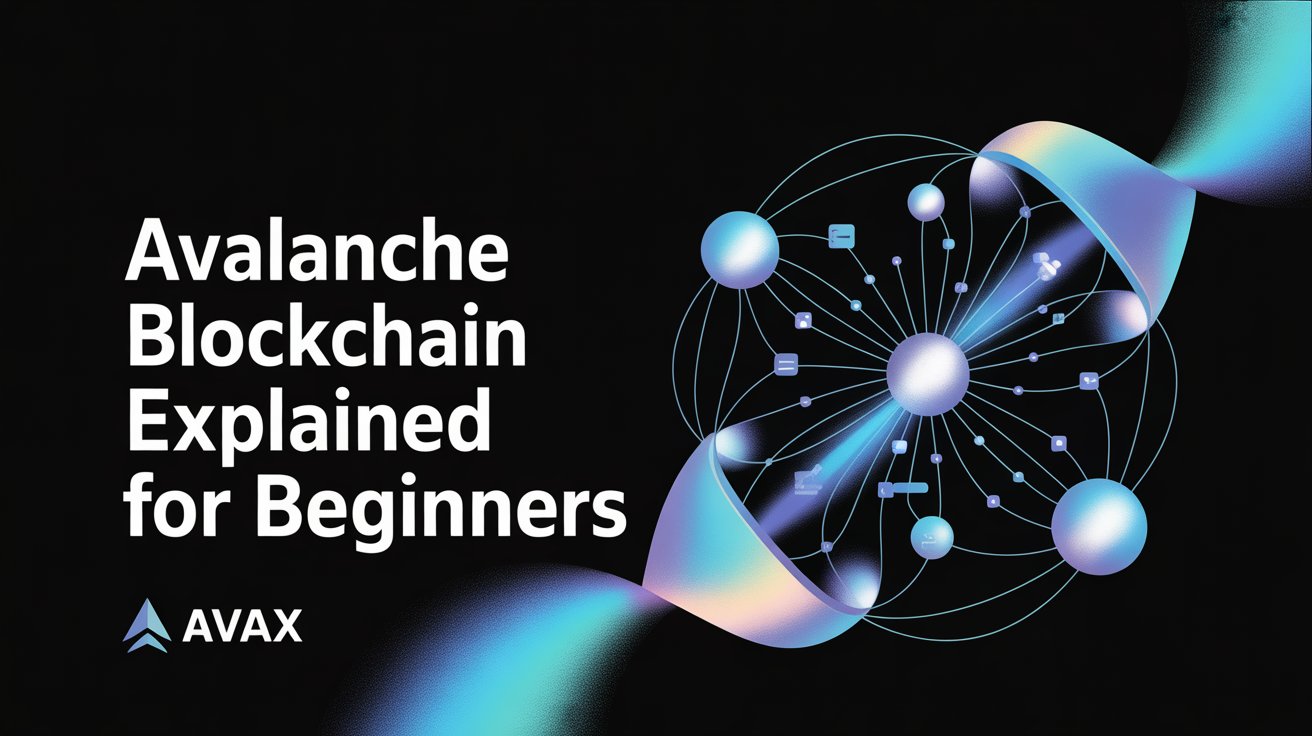Avalanche is a high-performance, scalable, and eco-friendly blockchain platform designed to support decentralized applications (DApps), custom blockchains (subnets), and smart contracts. Launched in 2020 by Ava Labs, Avalanche offers near-instant transaction finality, low fees, and full compatibility with Ethereum assets and tools. Its native token, AVAX, powers the network through staking, transaction fees, and governance. Avalanche is widely used in DeFi, NFTs, GameFi, and enterprise blockchain solutions, making it one of the most promising platforms in the Web3 ecosystem.
Introduction to Avalanche

Avalanche is a decentralized smart contracts platform designed for the creation of highly scalable and customizable blockchain applications. Developed by Ava Labs and launched in 2020, Avalanche aims to resolve the blockchain trilemma: achieving decentralization, scalability, and security simultaneously.
Unlike many earlier blockchain networks, Avalanche offers a unique consensus mechanism and subnetwork architecture, making it ideal for decentralized finance (DeFi), asset tokenization, and enterprise-grade blockchain solutions.
Its native token, AVAX, powers the network by serving as a medium of exchange, staking utility, and governance tool.
What Makes Avalanche Unique?
Avalanche stands apart from other blockchain platforms due to several key technological innovations:
1. Avalanche Consensus Protocol
- Unlike proof-of-work (PoW) or traditional proof-of-stake (PoS), Avalanche uses a novel consensus protocol that is faster and more energy-efficient.
- It achieves finality in less than two seconds, a major advantage for financial and enterprise transactions.
2. Subnets
- Developers can launch customizable blockchains, called subnets, that support private or public operations.
- Subnets allow regulatory compliance, data privacy, and high throughput for enterprise solutions.
3. Interoperability
- Avalanche supports the Ethereum Virtual Machine (EVM), enabling easy migration of Ethereum DApps to its ecosystem.
- The Avalanche Bridge (AB) allows cross-chain asset transfers with Ethereum and other chains efficiently and cheaply.
AVAX Token: Use Cases and Supply
| Feature | Description |
|---|---|
| Ticker | AVAX |
| Max Supply | 720 million |
| Circulating Supply | ~377 million (as of mid-2025) |
| Use Cases | Staking, Governance, Network Fees, Collateral |
| Token Burn | All transaction fees are burned, reducing supply |
AVAX is a deflationary asset, which enhances its potential for long-term value growth. Its staking rewards incentivize holders to secure the network, offering annual yields between 8-12%, depending on the lock-up period and validator uptime.
Avalanche Ecosystem Overview
Avalanche has built an impressive ecosystem that spans DeFi, NFTs, Web3, and enterprise-grade solutions. Here are some notable projects and integrations:
DeFi Platforms
- Trader Joe – Leading DEX (Decentralized Exchange) on Avalanche with lending, trading, and yield farming.
- Benqi – Non-custodial liquidity market protocol offering lending and borrowing features.
- Aave (Deployed on Avalanche) – Major Ethereum DeFi protocol using Avalanche for faster transactions and lower fees.
NFT Marketplaces
- Kalao – Advanced NFT marketplace with metaverse integration.
- Joepegs – Rapidly growing platform for art, collectibles, and gaming NFTs.
GameFi and Metaverse
- Crabada – One of the earliest GameFi projects on Avalanche.
- Shrapnel – AAA shooter game under development, fully integrated with Avalanche for asset ownership and trading.
Avalanche vs. Other Blockchains
To highlight Avalanche’s strength, here’s a comparative look against its major competitors:
| Feature | Avalanche | Ethereum | Solana | Polkadot |
|---|---|---|---|---|
| TPS (Transactions/sec) | 4,500+ | 15–30 | 65,000+ | ~1,000 |
| Finality Time | <2 seconds | ~1 minute | ~5 seconds | ~60 seconds |
| Consensus | Avalanche Consensus | PoW (ETH 1.0), PoS (ETH 2.0) | PoH + PoS | NPoS |
| Smart Contract Support | Yes (EVM-compatible) | Yes | Yes | Limited |
| Energy Efficiency | High | Low (ETH 1.0) | High | High |
Avalanche provides a balanced blend of speed, low fees, and security, making it a highly attractive alternative to Ethereum, especially for DeFi developers and institutional users.
Avalanche Partnerships and Institutional Adoption
Avalanche is increasingly gaining traction in the enterprise and government sectors:
- Deloitte uses Avalanche for its Close As You Go (CAYG) disaster recovery platform in collaboration with FEMA.
- Amazon Web Services (AWS) integrated Avalanche into its marketplace, making it easier for enterprises to deploy blockchain applications using Avalanche infrastructure.
- Mastercard Start Path Program selected Avalanche-based startups, signifying institutional recognition of its technological edge.
These strategic partnerships are critical in Avalanche’s roadmap to becoming a blockchain standard for both public and private sectors.
Investment Potential of AVAX
Price History Overview
| Year | Low Price | High Price |
|---|---|---|
| 2020 | $2.80 | $4.50 |
| 2021 | $9.30 | $146.00 |
| 2022 | $10.80 | $103.00 |
| 2023 | $10.10 | $21.45 |
| 2024 | $12.90 | $47.00 |
AVAX Price Prediction: 2025–2030
| Year | Price Range (USD) | Key Factors |
|---|---|---|
| 2025 | $50 – $120 | Institutional adoption, DeFi growth |
| 2026 | $80 – $150 | GameFi, increased subnet deployments |
| 2027 | $120 – $180 | More regulation-compliant use cases |
| 2028 | $160 – $220 | Token scarcity due to fee burning |
| 2029 | $200 – $260 | Global enterprise adoption |
| 2030 | $250 – $300+ | Avalanche as a multichain standard |
Disclaimer: Cryptocurrency investments carry risks, and price predictions are speculative.
Avalanche (AVAX) Price Prediction: 2025–2030
| Year | Minimum Price | Average Price | Maximum Price |
|---|---|---|---|
| 2025 | $50 | $85 | $120 |
| 2026 | $70 | $105 | $150 |
| 2027 | $90 | $130 | $180 |
| 2028 | $120 | $160 | $220 |
| 2029 | $150 | $200 | $260 |
| 2030 | $180 | $240 | $300+ |
AVAX Price Prediction 2025
Forecast:
- Min: $50
- Max: $120
- Avg: $85
Factors:
- Increased institutional use through Deloitte and AWS partnerships.
- Growth in DeFi and NFT projects built on subnets.
- Potential bull market driven by Bitcoin halving effects.
Analysis:
By 2025, Avalanche is expected to see wider adoption, especially in enterprise blockchain use cases. Its EVM compatibility and speed give it an edge for large-scale DApps and DeFi protocols. If crypto markets perform bullishly, AVAX could cross $100.
AVAX Price Prediction 2026
Forecast:
- Min: $70
- Max: $150
- Avg: $105
Factors:
- Expansion of GameFi and metaverse projects on Avalanche.
- Broader subnet adoption for custom blockchains.
- Improvements in cross-chain communication and security.
Analysis:
With Avalanche’s infrastructure maturing, it may attract institutional finance apps, real-world asset tokenization, and data-driven smart contracts. Subnet customization may appeal to companies needing regulatory compliance, pushing the price higher.
AVAX Price Prediction 2027
Forecast:
- Min: $90
- Max: $180
- Avg: $130
Factors:
- Launch of privacy-focused subnets and compliance-ready enterprise tools.
- Potential integration of Layer-2 rollups or zk-proof systems.
- Significant ecosystem expansion beyond DeFi.
Analysis:
2027 could mark Avalanche’s maturity phase, where it competes head-to-head with Ethereum and Solana in real-world use cases. Developers will likely launch compliant, high-speed financial platforms, and AVAX could ride the wave past $150 if overall crypto adoption grows.
AVAX Price Prediction 2028
Forecast:
- Min: $120
- Max: $220
- Avg: $160
Factors:
- Rising adoption of tokenized real estate, stocks, and commodities.
- Use in central bank digital currency (CBDC) sandbox programs.
- Further scarcity due to transaction fee burning model.
Analysis:
Avalanche’s deflationary mechanics (burning fees) will steadily reduce circulating supply, helping price appreciation if demand remains high. AVAX may see broader usage in cross-border settlements, pushing the price beyond $200 in optimistic scenarios.
AVAX Price Prediction 2029
Forecast:
- Min: $150
- Max: $260
- Avg: $200
Factors:
- Regulatory clarity boosts blockchain use in traditional finance.
- Avalanche becomes a Web3 infrastructure provider for banks, governments.
- Higher staking rates lower liquid AVAX supply.
Analysis:
As Web3 and digital identity protocols gain real traction, AVAX might see massive staking lock-up, reducing liquid token supply and driving up price. With enterprise subnets running in full capacity, AVAX could outperform many L1 tokens.
AVAX Price Prediction 2030
Forecast:
- Min: $180
- Max: $300+
- Avg: $240
Factors:
- AVAX considered a blue-chip crypto asset, similar to Ethereum today.
- Integration with AI, IoT, and quantum-resistant protocols.
- Potential rebranding or full-on Avalanche 2.0 deployment.
Analysis:
By 2030, AVAX may be powering thousands of independent blockchains through subnets and smart contract applications across every major sector—finance, healthcare, education, government, and entertainment. Price crossing $300 would require a multitrillion-dollar crypto market and AVAX having a dominant stake.
Key Drivers of AVAX Long-Term Price
- Subnet Adoption: Custom chains by banks, corporations, and developers will fuel demand.
- Transaction Fee Burning: Makes AVAX deflationary, reducing supply over time.
- Enterprise Integrations: Partnerships with Deloitte, AWS, and others add real-world value.
- Developer Incentives: Blizzard Fund and Multiverse Program encourage ecosystem growth.
- Energy Efficiency: Eco-friendly consensus makes Avalanche appealing in ESG-sensitive markets.
Risks to Price Growth
- Regulatory crackdowns on staking or DeFi projects.
- Competitor chains like Solana, Aptos, and Ethereum Layer-2s gaining more market share.
- Network congestion or security vulnerabilities affecting user trust.
- Loss of developer activity or DApp migration to other ecosystems.
Final Thoughts
Avalanche (AVAX) has all the components of a next-generation blockchain platform—speed, flexibility, eco-efficiency, and strong team backing. If adoption continues at its current pace, AVAX has strong potential to be among the top 5 cryptocurrencies by market cap by 2030.
However, price predictions remain speculative. Investors should always conduct their own research (DYOR) and consider diversified risk management strategies.
Staking and Passive Income with AVAX
AVAX offers strong opportunities for passive income through staking:
How to Stake AVAX
- Hold a minimum of 25 AVAX (for delegators).
- Use official wallet: Core Wallet or Avalanche Wallet.
- Choose a reliable validator and delegate your tokens.
- Select the staking period (14 days to 1 year).
Benefits of Staking
- Secure the network
- Earn annual rewards between 8%–12%
- Contribute to decentralization
Staking is ideal for long-term holders who prefer earning rewards over short-term trading.
Avalanche’s Role in Web3 and DeFi
Avalanche is one of the most promising platforms in the Web3 evolution:
- Fast and scalable DApps with low gas fees.
- Enables tokenized real estate, stocks, and commodities.
- Supports self-sovereign identity systems and cross-border payments.
These use cases align Avalanche with the next wave of digital infrastructure, offering real-world utility far beyond speculation.
Developer Ecosystem and Grant Programs
Ava Labs is actively nurturing innovation:
- Avalanche Multiverse Program: $290 million incentive fund to support subnets and novel projects.
- Blizzard Fund: $200 million fund for DeFi, NFTs, and culture-based Web3 applications.
- Developer Documentation: Comprehensive guides for building with Solidity, Rust, and Go.
These initiatives lower the barrier for developers and startups to launch scalable applications on Avalanche.
Challenges and Future Outlook
While Avalanche has many strengths, it must also navigate several challenges:
Current Challenges
- Increasing competition from Solana, Aptos, and Ethereum Layer-2s.
- Regulatory uncertainties around DeFi and staking rewards.
- Occasional network congestion during peak DApp usage.
Future Prospects
- On-chain governance improvements for better community decision-making.
- ZK-rollups and privacy features in future subnet upgrades.
- Possible integration with CBDC and real-world asset tokenization.
Avalanche is evolving rapidly and continues to solidify its position as a Web3 enabler.
Conclusion: Is Avalanche the Next Big Blockchain?
Avalanche combines high throughput, fast finality, energy efficiency, and flexible subnets into one cohesive ecosystem. It is well-positioned to become a dominant force in the cryptocurrency industry, especially as governments, enterprises, and developers search for reliable, scalable blockchain infrastructure.
For investors, developers, and everyday crypto users, Avalanche offers a compelling combination of performance and utility, ensuring it remains at the forefront of blockchain innovation.
